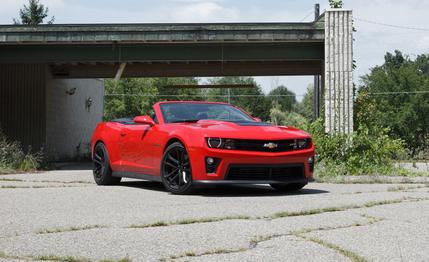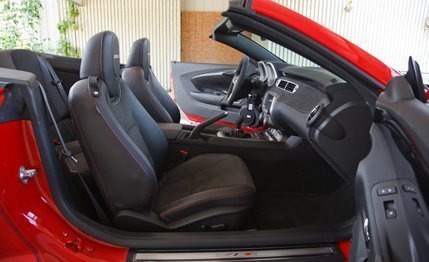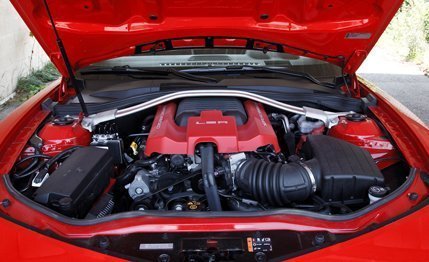
 Instrumented Test
Instrumented Test


Turning a sporty coupe into a breezy convertible is a practice as old as the pony car itself. First-generation models of the Ford Mustang, Chrysler ’Cuda/Challenger E-bodies, and GM Firebird/Camaro twins arrived with droptop siblings in tow or underwent the knife shortly after birth. So it surprised exactly no one when Chevrolet announced that the nostalgia-steeped fifth-generation Camaro would be available as a ragtop. But when word got around that a convertible version of the mighty ZL1 would arrive for 2013, more than a few people wondered whether the convertible’s chassis was up to the task of keeping the ZL1’s 580 hp and 556 lb-ft of chassis-twisting torque in check.
Tough Enough
Chevy reminds us that the current Camaro was conceived from the start to accommodate a convertible model. In addition to a host of chassis-stiffening measures already found on lesser Camaro convertibles, such as hydroformed steel tubes in the A-pillars, beefed-up door-hinge pillars, and a reinforcement bracket in the windshield header, ZL1 versions swap out the standard front chassis V-brace for a beefier four-point X-brace to help keep the body from pretzeling on hard launches. All this stiffening and the convertible top add a few pounds to an already portly vehicle; this manual-transmission convertible weighed 4373 pounds, 255 more than a similarly equipped ZL1 coupe we tested.


We put the top down and took to wavy and broken rural roads determined to elicit at least a quiver from the chassis. There was some subtle movement where the doors meet the bulbous rear fenders, and the car had a less-solid feel on seriously cratered pavement than did the coupe. The ZL1 is relatively stout in convertible form, but if you’re expecting the body to be as rock solid as the coupe’s, you’re going to be disappointed.
Much of the credit for this convertible’s civilized behavior goes to GM’s Magnetic Ride Control. Like the coupe, the droptop ZL1 uses the third-generation system, which features twin-wire, dual-coil dampers at all four corners for faster response. Chevrolet says the setup can adjust damping levels up to 1000 times per second, which equals roughly one adjustment per inch of vehicle travel at 60 mph.


Tracks of My Gears
With the ZL1 badge on the rear and the same supercharged 6.2-liter LSA V-8 that powers the coupe, brutal acceleration is a given. Forward thrust can be summoned in any gear, and with all that torque, shifting is almost optional. Stab the pedal for short spurts, or toe in easy for a long, linear ascent, and the powertrain responds accordingly and without complaint.
The same Tremec TR6060 MG9 six-speed manual that appears in the coupe is standard here. GM made some changes intended to improve shift feel, but the setup still telegraphs a heavy-duty vibe to the user. Its action is reasonably precise and direct, but it doesn’t try to conceal the fact that it’s on the receiving end of 556 lb-ft of torque, which it’s attempting to send to the rest of the driveline without exploding.


The rest of the driveline can take the punishment, too. According to GM engineer Mark Dickens, not a single rear end was grenaded during ZL1 development. And they tried. Empowered with that information, the “no-lift shift” feature that permits foot-to-the-floor gearchanges, and the ZL1’s nifty launch control, we wasted at least an hour re-creating several of top-fuel drag racing’s greatest moments.
For the full picture, we also got some seat time in an automatic-equipped convertible. This six-speed transmission is itself just back from finishing school, incorporating a tweak in Chevrolet’s tap-shift software that lets it execute paddle-actuated upshifts 60 percent (200 to 300 milliseconds) quicker than with the previous setup. The shifts indeed click off with little hesitation, and in manual mode, the transmission will hold a gear indefinitely. If you simply must have an automatic, you could do a lot worse than the ZL1’s Hydra-Matic 6L90.